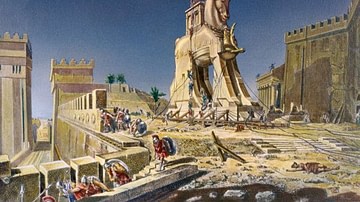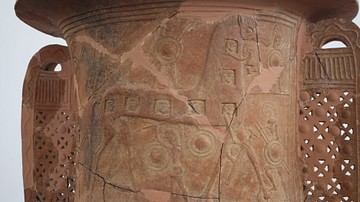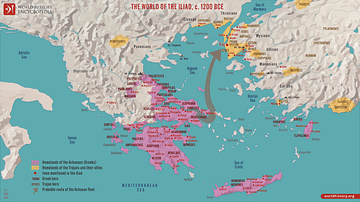The sculpture group of Laocoön and His Sons, on display in the Vatican since its rediscovery in 1506, depicts the suffering of the Trojan prince and priest Laocoön (brother of Anchises) and his young sons Antiphantes and Thymbraeus and is one of the most famous and fascinating statues of antiquity. In his Natural History, Pliny the Elder states that the Laocoön, created by the eminent Rhodian sculptors Hagesander, Polydorus, and Athenodorus, “is a work of art to be preferred to any other painting or statuary” (36.37). Among art historians, the sculptural group has received near-universal acclaim ever since its rediscovery under questionable circumstances in 1506.
Is the statue famously shown since its discovery in the newly designed Belvedere Garden at the Vatican Palace actually the ancient sculpture mentioned by Pliny, or rather a clever Renaissance forgery? If the latter, who may have contrived this masterful deception? If the former, is it an original, or a marble copy of a Hellenistic bronze made for a Roman patron?
Beware of Greeks Bearing Gifts
In the most famous version of the story, as told by Virgil (70-19 BCE) in his Aeneid, Laocoön had warned his fellow citizens against the Greeks “even if they bear gifts,” and had tried to expose the true nature of the wooden horse by striking it with a spear (the wooden horse in question, of course, being the notorious “Trojan Horse”, left by the Greek forces on the coast so as to provide access into the city to the troops hidden inside the construction). When later two serpents emerged from the sea to kill the priest and his sons, the Trojans interpreted their horrific deaths as an act of divine retribution and promptly decided to move the wooden horse into the city, believing the contraption to be an offering to Minerva (Athena).
According to Arctinus of Miletus, the earliest tradition of the tragedy (surviving only through later citations), Apollo had sent the two serpents to kill Laocoön and only one of his sons; while the later author Quintus of Smyrna maintains that the serpents killed both sons but spared the father.
Servius, another late authority (c. 400 CE), tells us how Laocoön managed to incur the wrath of Apollo by sleeping with his wife before the cult statue in the god's temple. An even later source, the Byzantine scholar Tzetzes, adds that the scene of Laocoön's death took place in the very temple of the Thymbraean Apollo – appropriately setting the punishment at the scene of the crime.
The 5th-century BCE Greek playwright Sophocles produced a tragedy on the subject, of which only a few fragments survive in later citations. Apart from the sources mentioned above, Hellenistic poets Apollodorus and Euphorion, the historian Dionysius of Halicarnassus, the Roman novelist Petronius, the Latin fables attributed to Hyginus, and a few other fragments, all provide various details of the tragic story.
Despite this appearance in ancient literature from the post-Homeric to Byzantine traditions, artistic representations of Laocoön's suffering are few and far between. Depictions appear in some Greek vase paintings (5th to 4th centuries BCE) and in two frescoes at Pompeii (c. 25-75 CE). The marble statue group of Laocoön and His Sons, therefore remains the most exceptional portrayal of only a handful of ancient works illustrating the suffering of Laocoön.

Michelangelo & the Rediscovery of the Laocoön
After the 1st century CE, the suffering of Laocoön seems to have gradually slipped from memory. It was not until the Renaissance that his tragedy – and more importantly the art-historical significance of the marble statue group – was fully recognized. This rediscovery, however, is not without its problems. For one, Felice de Fredis is said to have unearthed the sculpture well-nigh intact on 14 January 1506, while laying the foundation of his house on a newly purchased vineyard on the Oppian Hill. Informed of the discovery, Pope Julius II sent for his architect Giuliano da Sangallo as well as Michelangelo Buonarroti to inspect the still partially interred sculpture.
Recognized on the spot by Da Sangallo as the Laocoön mentioned by Pliny, the pope acquired the artwork by 23 March 1506 and put it on public display within half a year in the Belvedere Garden, newly designed that year to connect the former Belvedere Palace with the Vatican Palace (now part of the Vatican Museums).
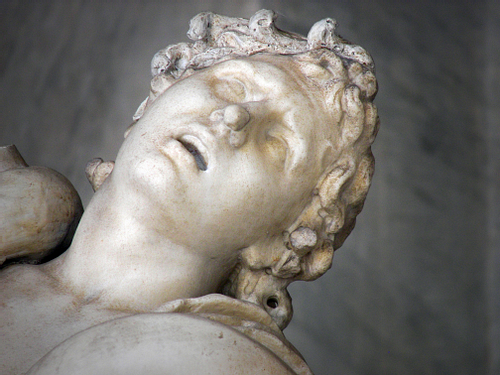
While the statue group was remarkably well-preserved for a work unearthed after nearly 1500 years, several pieces were notably lacking: most importantly Laocoön's right arm, part of the hand of the elder son, the right arm of the younger son, and several segments of the snakes; finally, the back of the altar is of different marble (raising doubts about its date).
In 1510, an informal contest was held among artists inviting suggestions, of which Raphael was to be the judge, for the restoration of Laocoön's right arm. Jacopo Sansovino, the sculptor of works on the Piazza San Marco in Venice, won the contest with his suggestion of a heroically outstretched arm; Michelangelo had suggested that the missing arm should be bent backwards to the shoulder. Years later an even more outstretched arm was indeed added to the figure of Laocoön; the younger son's arm and missing parts of the snakes were added in later centuries.
Amazingly, in 1905, classical archaeologist Ludwig Pollack discovered part of a marble, backwards-bent arm in a yard near the site where the Laocoön itself was unearthed. Half a century later the “Pollack arm” was added to the statue, as it was shown that a drill hole in the arm fitted perfectly with a corresponding hole in the shoulder.
When the group was disassembled in the 1980s, both ancient and early modern alterations were discovered from various breaks, cuttings, holes and the metal tendons connecting the separate pieces. The disassembly has led Seymour Howard to conclude that the original composition of the Laocoön was a more compact, dynamic, diagonally-set pyramidal and thus more cohesive composition in line with a late-Hellenistic 'baroque' style inspired by mid-Hellenistic artwork from Pergamon.

According to art historian Lynn Catterson, Michelangelo's presence during the discovery of the Laocoön was far from coincidental. Based on careful research of circumstantial evidence she maintains that the Laocoön is a carefully crafted Renaissance forgery. Indeed, she suggests that it was Michelangelo who had “the motive, the means, and the opportunity” to create this fraudulent artwork – meaning the ambition to deceive his contemporaries (as he had done before), the money to purchase the marble (as his papers prove), and the time to produce the fraudulent work in the years before its discovery (around the same time he created his unprecedented masterwork Pietá).
Difficult as it is to imagine that Michelangelo himself would not eventually have revealed his magnificent deceit, it is even less likely that none of his contemporaries spoke out about the forgery – as he must have had accomplices, if not in the actual creation then at least in the transportation to the findspot in the vineyard. It is commonly understood that, conversely, the Laocoön had a profound effect on the development of Michelangelo's style. It remains unclear where he would have found his inspiration for this masterwork. Moreover, stylistically the Laocoön corresponds to Hellenistic works of art unknown to Michelangelo – such as the Pergamon Altar (now in Berlin and excavated in the late 19th century) and the Sperlonga sculptures (discovered in 1957 at the ruined villa of Tiberius, between Rome and Naples). For these and other reasons, most if not all art historians dismiss Catterson's assertion as problematic and thus highly improbable.
From Imperial Commission to Art-historical Ideal
According to Pliny, the Laocoön was set up in the palace of the Roman emperor Titus (r. 79-81 CE), the son and successor of Vespasian (r. 69-79 CE). The location of that palace is, however, not known. The vineyard of Felice de Fredis was just inside the Servian Wall on the southern spur of the Esquiline east of the Sette Sale (the cisterns) supplying the nearby Roman Baths of Titus and Trajan (built over the reviled Domus Aurea of Nero) across from the Colosseum. This area of the Esquiline once was the site of the Gardens of Maecenas, where later Tiberius (r. 14-37 CE) resided after his return to Rome. Pliny's statement about Titus might be interpreted as an indication of an imperial commission.
However, a more significant indication of the date – and possible commission – was discovered in 1957 at the site of the collapsed grotto on the grounds of the villa of Tiberius at Sperlonga (on the coast between Rome and Naples). For among the Hellenistic marble sculptural groups with Homeric themes at Sperlonga, the ship of the Scylla scene is signed by the three sculptors Athenodoros, Agesandros, and Polydoros.
Significantly, these are the very same names as the three Rhodian artists to whom Pliny attributed the Laocoön (though, of course, he provides Latinized versions). While the Sperlonga sculptures may have been commissioned a generation earlier, the connection with Tiberius and the Homeric themes of the groups as well as of the Laocoön (relating to Tiberius' supposed mythical descent from Odysseus and Aeneas), evidently points to a date in the early 1st century CE (the Sperlonga grotto collapsed in 26 BCE, nearly killing Tiberius himself) – and what is more: Tiberius retired to Rhodes for some years (6 BCE to 2 CE), before being recalled to Rome by Augustus (r. 27 BCE - 14 CE).
Modern historians indeed generally accept that the Laocoön and His Sons on display in the Pio-Clementino Museum at the Vatican can be identified as the artwork mentioned by Pliny. Restoration efforts in the last century have shown, however, that the statue group consists of seven pieces. This would seem to contradict Pliny's claim that the work was carved “from one [block of] stone.” The statement could be construed such that the sculptors used a single piece of marble, which had to be cut into several pieces, for instance for the sake of transportation, or some other reason; the sculpture may also have been reconstructed in antiquity after Pliny's time (as the disassembly seems to confirm); or he may have been deceived by invisible joins.
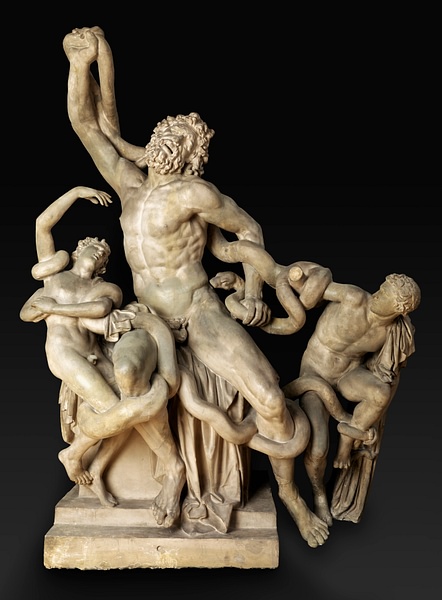
Even if the Vatican Laocoön is the very same artwork as mentioned by Pliny – and possibly commissioned by Tiberius for his residence in the Gardens of Maecenas – there have been two competing views about its origin: a masterwork of early Roman sculpture in late-Hellenistic “baroque” style, or a marble copy of a mid-Hellenistic bronze work, perhaps from the Pergamene school (2nd century BCE).
The older view that the Laocoön itself dates to the 2nd century BCE has now lost its ground. While stylistic features do associate the Laocoön with the Pergamene school, the general artistic disinterest in the subject matter of Laocoön's suffering in the Hellenistic period might favour the suggestion that the three Rhodian sculptors created their masterwork from their own inspiration and on Roman commission – and have inspired the near-contemporary upswing in its depictions at Pompeii.
It is not surprising that the Laocoön group made such a big impression on Renaissance artists such as Michelangelo. The vivid facial expressions of the near life-size figures radiate agony, desperation, and anguish. The malevolent snakes winding around the bodies do not only strangle their victims but also bite their flesh with their poisonous fangs in an endless scene of torture. The figures' dynamic, distorted poses clearly show their pain and distress. The sculpture is a masterpiece of emotion, action, and drama, and became an inspiration for artists almost directly after its unearthing, not in the least Michelangelo himself.
A version of this article was originally published at AncientWorldMagazine.com.




